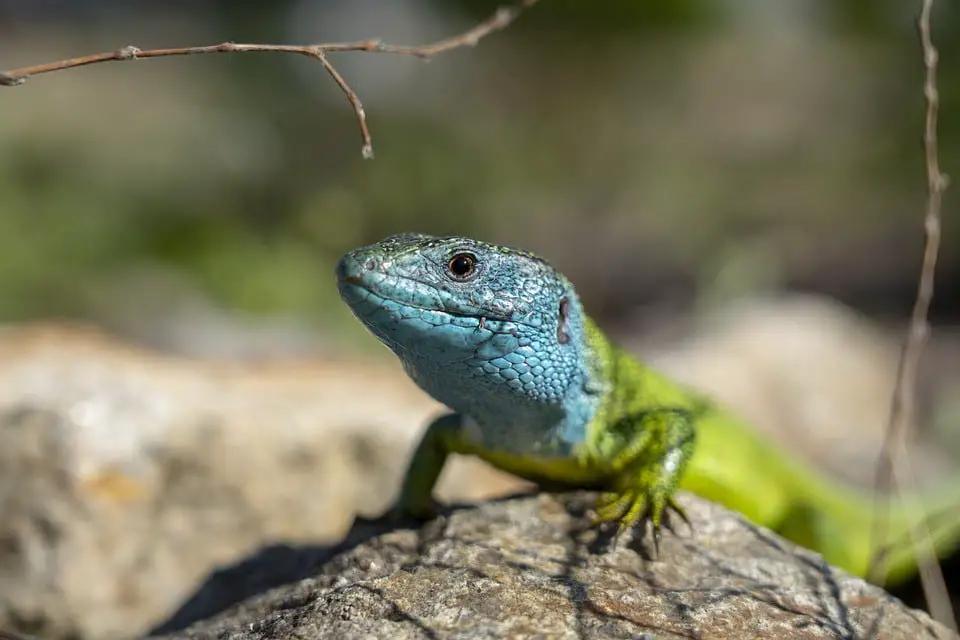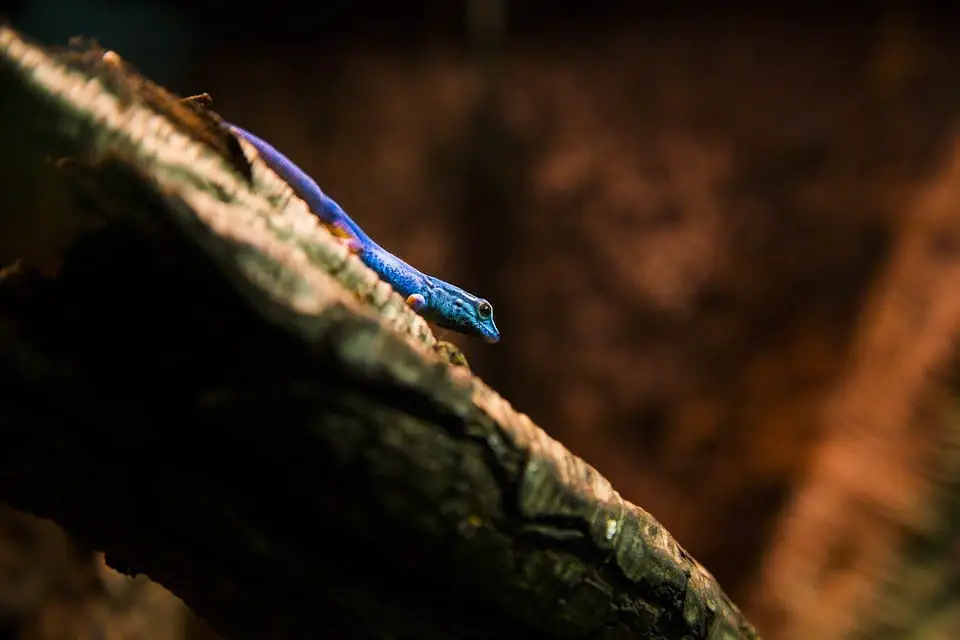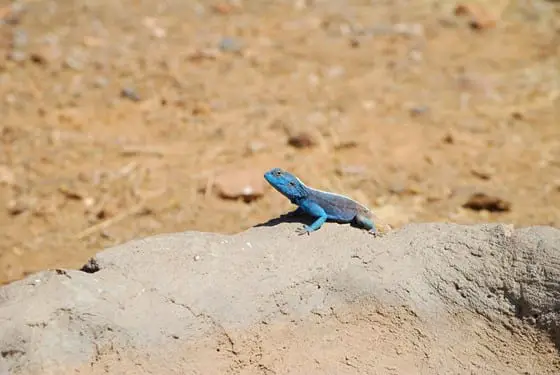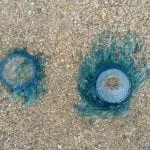The electric blue gecko, scientifically called Lygodactylus williamsi is native to the rainforests of the region in and around Tanzania, Africa. It belongs to the family Gekkonidae. Being a highly endangered species of lizards, it occupies only a few square patches of these Tanzanian rainforests.
It is also commonly known as a turquoise dwarf gecko or William’s dwarf gecko.
The electric blue gecko is one of the most sought after reptiles in the pet trade and among reptile keeping hobbyists. Collecting these rare reptiles from their natural habitat is prohibited by law.
So what makes the electric blue gecko so interesting? Let us dive into some interesting facts about this species.
Interesting facts about the electric blue gecko
1. The electric blue gecko is now classified as a critically endangered species. They are endangered mainly because of its wide involvement in the illegal international pet trade, and to some extent because of large scale deforestation.
2. It lives mainly on the plant Pandanus rabaiensis, also called the screwpine. It lives on the leaf crowns of these plants. Each leaf crown mainly contains one adult male or female blue gecko.
3. The adults grow up to only 3 inches in length, thereby making it ideal for keeping as pets in small enclosures.
4. Though named the electric blue gecko, the adults display prominent sexual dimorphism (the two sexes look different from one another). Only the adult males have the characteristic of exhibiting the characteristic striking blue color that gives it its name. The adult females and young ones are usually either bronze or green in color. The juveniles exhibit the same greenish color regardless of their sex.

5. The adult geckos exhibit prominent sexual dimorphism. In breeding, differentiating between the two sexes is the most common problem. The adult dominant males are electric blue, thereby giving the species its common name. The females and submissive males vary in color from green to copper, and sometimes aqua. Further, the males have a jet black throat region while the females lack this coloration. Both sexes often have black stripes around their eyes and snout, but these stripes are far more prominent in the males. Other than the colors, the only other way to determine the sex of a gecko is to examine their pre-anal pores.
6. Dominant males are the only adults that exhibit the characteristic blue color. This means that if two males are kept in the same enclosure, the more submissive male will remain colored green or copper.
7. The color varies according to their moods and the surrounding temperatures.
8. It is the characteristic blue color of the adult males that make them so popular in the illegal pet trade.
9. The way an adult male courts an adult female blue gecko is quite interesting. The male flattens his body, puffs out his black throat patch, and begins to bob his head.
10. Other than the threat to this species by its popularity among illegal pet traders, it also faces the threat of extinction by other factors. Deforestation for agriculture is one of the factors that threaten the electric blue gecko into extinction.
11. There are around 250 electric blue geckos living in zoos worldwide.
12. They are nectar-eating insectivores. They feed on the smallest insects such as fruit flies, crickets, bean beetles, houseflies, and woodlice.
13. The name williamsi was given by the British zoologist, Arthur Loveridge. It was given by him in honor of the American herpetologist, Ernest Edward Williams.
14. The adult males are dominant and territorial. They don’t often tolerate the presence of other males in the same area like the one they live in. When two or more dominant males are housed in the same modest enclosure, they often get defensive and start chasing each other around. The adult males are also bold, active, and social creatures.
15. Collectors often cut down the barks of the screwpine plant in order to catch these geckos. This practice endangers the screwpine plant equally, along with the geckos. It is due to this fact that the rainforests that house these electric blue geckos are also becoming increasingly depleted. However, the pet trade is a worse threat than habitat loss. There is little of the forest left un-depleted.
16. The female geckos are called “egg-gluers”. This is because of the fact that when they lay eggs, the eggs dry up and attach very quickly to the surface upon which they are laid. Thereafter, these eggs are impossible to remove unless they are destroyed.
17. The sex of the electric blue geckos depends on the temperature at which the hatched eggs are incubated. It is said that average daily temperatures of 70-76 degrees yield female, whereas 78-81 degrees will produce both males and females. Temperatures above 81 degrees usually yield only males.

18. Although these geckos are highly sought after among reptile keepers and pet traders, they require quite a high level of maintenance. They require just the right levels of humidity, temperatures, and the right sized enclosures in order to be bred successfully. They require consistently high-quality diets and clean water to maintain its usual bustling activity levels.
19. The electric blue gecko lives on the Pandanus tree, which has dense stalks and above-the-ground roots. It is because of this characteristic that the geckos were easily found by poachers. As a result, thousands of blue geckos were illegally removed and exported illegally. By 2008, the species was in an extremely critical position in the wild.
20. In order to slow the import frenzy, very few breeders are producing captive-bred geckos. Due to this, poachers continue to remove the geckos from the wild as reptile hobbyists are so eager to own them.
Facts about breeding the electric blue gecko
1. Small enclosures are best for these dwarf-sized geckos. Finding a suitable terrarium is often challenging. Terrariums made especially for reptiles are often used successfully.
2. Because of its small size, controlling its hydration and humidity is essential. It does best in steady temperatures that most closely resemble the temperatures of its native land. Humidity levels ranging from 60 percent to 80 percent are ideal. Temperatures should be monitored closely using a digital thermometer.
3. The enclosure should be furnished with adequate accessories, making it resemble the geckos’ natural habitat as closely as possible. This means filling it with live plants, succulents, bark, natural sticks, and branches. Multiple sticks and branches kept in vertical and semi-horizontal positions are ideal for the bustling activity of a healthy adult blue gecko. It is most ideal to keep the enclosure painted a natural color that mostly resembles the wild.
4. Lighting is an essential component of gecko health. Electric blue geckos are essentially diurnal creatures (animals that are active during the day). Therefore, they seek the morning sun. By midday, they seek shelter in foliage in order to stay cool. While considering the matter of lighting in the enclosure, maintaining a proper temperature gradient is essential. The most traditional method of providing them with adequate lighting is using overhead fluorescent strips in combination with a heating lamp for basking. Alternatively, if the geckos are being housed in larger areas, a mercury vapor bulb can also be used.
5. At night, if the surrounding temperatures are expected to drop below 70 degrees, a form of night time heating is highly recommended.
6. Basking spots should be provided in every gecko enclosure. An ideal basking spot is made using heating lamps.
7. During breeding, the females should be provided with specific sites for laying eggs. If such a site is not provided, the eggs are usually laid on the walls of the terrarium.
8. Once the eggs are hatched, it is important to remove them from the enclosure as the parents are likely to eat them! It is also important to subject them to proper temperatures in order to determine their sex. Many breeders leave the eggs in the same warm temperatures where they are laid. This is the reason more male geckos are available for breeding as opposed to females.
9. When they are properly cared for, the electric blue geckos are highly prolific in captivity. Their entire life cycle is fast-paced.
10. It is not recommended to handle these blue geckos often. When held, they become stressed quite easily. Some males may take a certain initiative, though, and climb onto the keeper’s hand to bask while the keeper tends to the enclosure!
11. Since these geckos require a comparatively high level of humidity, many breeders have taken to misting their enclosures using either hand misters or automated misting systems. Though misting is essential, it is important to remember not to leave the geckos in habitats that are too wet.

The most important thing to remember about these fascinating reptiles is the fact that they are critically endangered, and their illegal poaching should be strongly discouraged and turned down. Along with making sure they get sold only to legal keepers and breeders, their removal from their natural habitat should be stopped as well. They are fascinating creatures to keep as pets and are exciting to watch and study!




